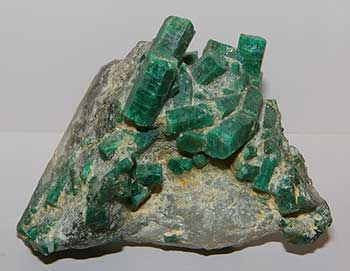 |
| Beryl - Be3Al2Si6O18. |
Beryllium is a metallic element, with atomic number 4 and atomic weight 9. The metal is hard, silvery-white in color, and very light. It is less than twice as dense as water and only two-thirds as dense as aluminum, which it somewhat resembles. Beryllium has a very high melting point at 1,287 °C (2,349 °F). The combination of its light weight and high melting point make it valuable for making metal alloys, which are used in electronic and electrical components and aerospace and defense applications.
Because of the toxic nature of beryllium, careful control over the quantity of dust and fumes in the workplace must be maintained.
Name
Beryllium was not known to ancient or medieval civilizations, and was first recognized by the French scientist, Nicholas Louis Vauquelin in 1798. He discovered it as a component of the mineral beryl, and named it beryllium. Metallic beryllium was not isolated until 1828, by Friederich W'hler in Germany.
Sources
The most common mineral containing beryllium is beryl, a silicate mineral with the chemical formula Be3Al2Si6O18. Beryl forms distinctive hexagonal prisms, and is found in the igneous rock granite and special igneous rocks, derived from granites, known as pegmatites. Colored, transparent varieties of beryl may be gems, such as emerald (green), aquamarine (blue-green), heliodor (yellow), and morganite (pink). In addition to being found in beryl, beryllium is found in the mineral bertrandite Be4Si2O7(OH)2, which in recent years has become a major ore of this element, in addition to beryl. Bertrandite is found in certain volcanic rocks derived from granite.
Bertrandite ore mined in Utah makes up nearly all of U.S. production, which is about two-thirds of the world supply. Russia produces most of the rest, from beryl ores. Five to ten other countries mine small amounts of beryl. The United States produces and exports large amounts of beryllium alloys and compounds, and thus is a net importer of ores, but a net exporter of finished beryllium products.
Small amounts of beryllium become available from recycling of beryllium-containing scrap.
Uses
Most beryllium is used in metal alloys, which account for more than 70% of world consumption. Because beryllium is very light and has a high melting temperature, it is an ideal metal for use in the aerospace and defense industry, almost always alloyed with other metals. Beryllium metal also has the interesting characteristic of being elastic. Consequently, it is used in the manufacture of springs, gears and other machine components that need a degree of elasticity. Another everyday application is in the manufacture of gasoline pumps, because an alloy of copper and beryllium (beryllium bronze) does not spark when hit against other metals, nor emit sparks from static electricity.
Rods made of beryllium metal and oxide are used to control nuclear reactions, because beryllium absorbs neutrons better than any other metal.
Most organisms do not depend on beryllium for growth. In fact, beryllium dust and fumes can be dangerous to human health when inhaled. Consequently, the Clean Air Act demands very careful handling of beryllium dust and fumes to minimize or eliminate its danger to humans.
Substitutes and Alternative Sources
In some applications, graphite, steel and titanium can be used in place of beryllium. However, it is a critical component of many military and aerospace applications, and even though it is expensive to produce (costing more than silver), it is not often replaced by other materials.